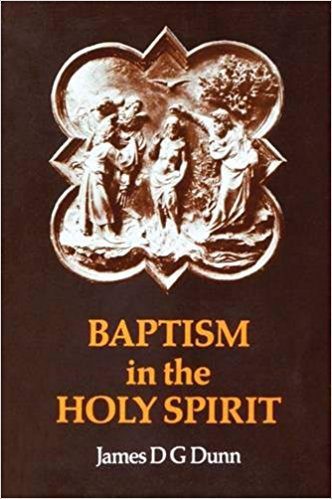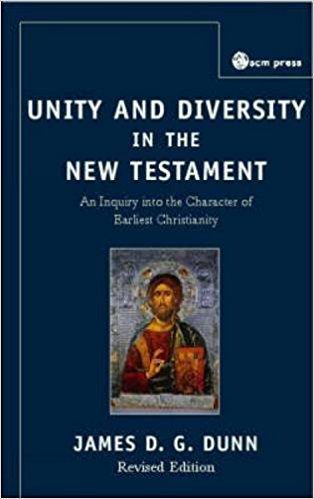James (Jimmy) D. G. Dunn is a Methodist, a moderate Evangelical, a distinguished New Testament scholar now retired, a very cordial person, and my friend. His doctoral dissertation bec ame his first book, published in 1970. It is entitled Baptism in the Holy Spirit: A Re-examination of the New Testament Teaching on the Gift of the Spirit in relation to Pentecostalism today. In this book, I don’t think Jimmy is clear on whether or not he subscribes to baptismal regeneration, though I would say he seems to do so. In a later book about the Spirit, he does not subscribe to baptismal regeneration.
ame his first book, published in 1970. It is entitled Baptism in the Holy Spirit: A Re-examination of the New Testament Teaching on the Gift of the Spirit in relation to Pentecostalism today. In this book, I don’t think Jimmy is clear on whether or not he subscribes to baptismal regeneration, though I would say he seems to do so. In a later book about the Spirit, he does not subscribe to baptismal regeneration.
Here are Jimmy’s statements in Baptism that seem to me to endorse baptismal regeneration:
- To me, Jimmy’s coined term “conversion-initiation” and his explanation of it, on p. 7, seem to indicate baptismal regeneration.
- Jimmy says, “Baptism as an act eis to onoma Iesou Christou is man’s way of accepting God’s offer of salvation and of ‘clinching the bargain’ with God. When we look for God’s means of effect in salvation we find them in the Spirit and the gospel. We can therefore say that he [the Holy Spirit] is the vehicle of God’s saving grace as baptism is the vehicle of man’s saving faith” (p. 120). Well, Jimmy says if a person does not have the Spirit she/he is not saved. It must be concluded from the last clause in this statement that if a person has not been water baptized, she/he is not saved. I would say of Jimmy’s first sentence here that a person accepting God’s offer of salvation is by faith, and water baptism is merely an expression of that faith in which water baptism symbolizes Jesus’ death and our cleansing from sin—God’s forgiveness.
- Dunn says, “The popular idea that conversion precedes baptism, and that baptism is a confession of a commitment made some time previously is not to be found in the NT” (p. 214). But in Acts people believed and right afterwards were baptized because they had repented/believed (Ac 2.38-41; 10.44-48; 16.31-33).
- Jimmy says, “The second mistake of the Pentecostal is that he has followed the Protestant in his separation of faith from water-baptism. Conversion is for him Spirit-engendered faith reaching out to ‘receive or accept Jesus,’ so that a man is a Christian before his water-baptism. This may well accord with present Baptist practice, but it is not the NT pattern. The NT writers would to a man reject any separation of the decisive movement of faith (pisteusai) from baptism, either by way of putting the act of faith prior to baptism, thereby reducing baptism to a mere symbol,… Baptism properly performed is for the NT essentially the act of faith and repentance—the actualization of saving faith without which, usually, commitment to Jesus as Lord does not come to its necessary expression. As the Spirit is the vehicle of saving grace, so baptism is the vehicle of saving faith” (pp. 2226-27). In my book, Solving the Samaritan Riddle, I tell of my being saved and baptized twenty-two years, and I explain why this abnormality happened.
James Dunn soon wrote another significant book entitled Unity and Diversity: An Inquiry into the Character of Earliest Christianity. It was published in 1977, with a second edit ion in 1990 (the issue to which I refer here). In contrast with Baptism, I don’t think Jimmy says anything in Unity and Diversity that causes readers to think he subscribes to baptismal regeneration. Sometimes, he seems to write against the idea of baptismal regeneration without using this terminology. Numerous times in his section on water baptism (pp. 152-161), Dunn describes it as an “expression” or “expressing” of “faith” or “repentance and faith,” that is, conversion without saying “conversion” as the following reveal (emphasis his):
ion in 1990 (the issue to which I refer here). In contrast with Baptism, I don’t think Jimmy says anything in Unity and Diversity that causes readers to think he subscribes to baptismal regeneration. Sometimes, he seems to write against the idea of baptismal regeneration without using this terminology. Numerous times in his section on water baptism (pp. 152-161), Dunn describes it as an “expression” or “expressing” of “faith” or “repentance and faith,” that is, conversion without saying “conversion” as the following reveal (emphasis his):
- “water-baptism … is best understood as the expression of the faith” (p. 5).
- “Baptism gives expression to faith,… It is false to say that water-baptism conveys, confers or effects forgiveness of sins…. it is the faith and repentance which receives the forgiveness,… In other words, water-baptism is neither the sole preliminary nor in itself an essential preliminary to receiving forgiveness” (p. 97).
- “the attention which theologians have devoted to water-baptism … is to be regretted” (p. 102).
- On Paul he says, “baptism is not at the heart of his salvation strategy … baptism had no indispensable role and only the gospel mattered” (pp. 119-20). Here Jimmy clearly rejects baptismal regeneration for Paul, and he quotes 1 Cor 1.14.
- “If the NT is to be our rule, therefore, the rite of water baptism may not be given the central role in conversion-initiation. It symbolizes the spiritual cleansing” (p. 228).
- Concerning “the first Christian baptisms … Baptism was an expression of repentance and faith” (p. 155).
- Concerning “earliest Christian baptism … the first Christians … needed a tangible way of expressing faith” (p. 156).
- “baptism did not serve as the expression or channel of God’s action” (p. 156).
- “Christian baptism remained primarily the expression of man’s action (repentance/faith) towards God” (p. 157).
- “Paul clearly thinks of baptismal immersion as symbolizing burial with Christ;… as symbolizing death and burial … baptism, symbolizing burial for Paul” (p. 158).
- “Paul did not give to baptism the role which circumcision played in the Judaism of his time…. he argues against a ritualism without reality, but not in favor of a ritualism with reality” (p. 159).
- “It was circumcision of the heart, not baptism, which had replaced the ritual act of old Israel,” referring to circumcision (p. 160).
- “baptism is … the means of expressing commitment to Jesus as Lord” (p. 160).
- “baptism was still the expression of man’s faith” (p. 160).
- Concerning “infant baptism,” in the church “the chief means of accomplishing regeneration for so many centuries has had so little foothold in the NT” (p. 160).
- “a primary function of baptism throughout the first decades of Christianity was to serve as a means of expressing the initiate’s faith and commitment” (p. 160).
- “the new covenant equivalent of old covenant circumcision is the circumcision of the heart, the gift of the Spirit, not baptism; and membership of the new covenant is through faith in Christ Jesus, not natural descent” (p. 161).
 The difference in the two books seems to regard Jimmy’s use of the words “conversion” and “forgiveness.” I view conversion as an inner transformation that occurs when people repent of their sins and believe in Jesus. God then immediately forgives them. Water baptism necessarily occurs afterwards. It symbolizes Jesus’ death with which the baptisand associates. So, baptism is a physical act that serves as a testimony to the baptisand’s inner faith in Jesus’ sacrificial death for his/her sins.
The difference in the two books seems to regard Jimmy’s use of the words “conversion” and “forgiveness.” I view conversion as an inner transformation that occurs when people repent of their sins and believe in Jesus. God then immediately forgives them. Water baptism necessarily occurs afterwards. It symbolizes Jesus’ death with which the baptisand associates. So, baptism is a physical act that serves as a testimony to the baptisand’s inner faith in Jesus’ sacrificial death for his/her sins.













